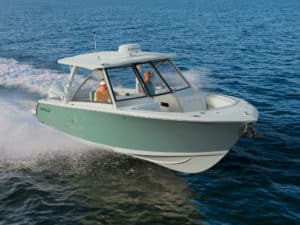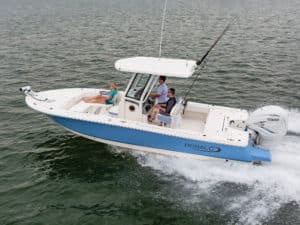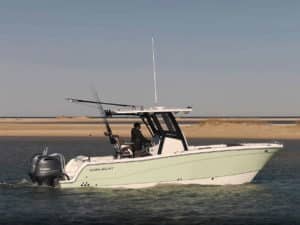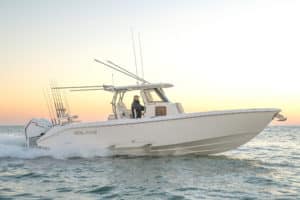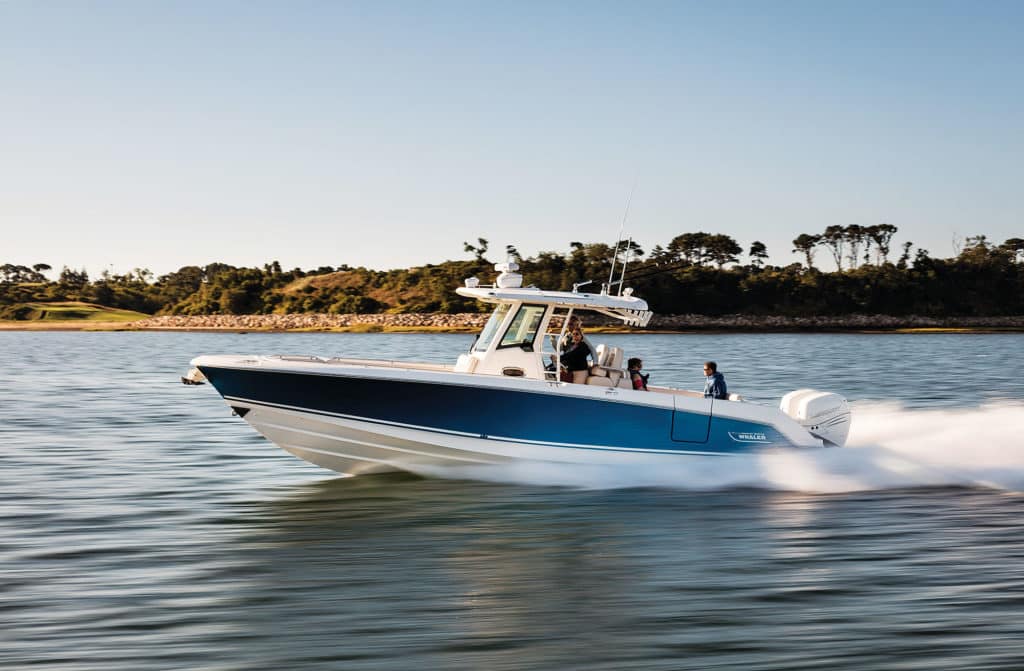
A whistling north wind signaled a rough day on the water as Capt. Wil Rogers piloted the new Boston Whaler 330 Outrage through Dispatch Creek in North Key Largo, Florida, en route to the edge of the Gulf Stream.
“Jim, it might be sporty out there,” said Rogers, large-boat business manager for Boston Whaler. “That’s OK. I’m not worried,” I replied.
My confidence was inspired by my experience with other Outrage models and the knowledge that, as on all Whalers, the 330’s foam-filled Unibond construction renders it unsinkable. Rogers advanced the digital throttles for the twin Mercury 350 Verado outboards, running them up to 4,000 rpm, which resulted in a speed of around 30 mph and a smooth ride through the three-foot waves inside the patch reefs.
Crew on this late-February morning included Traci Davis, manager of content development and events for Whaler; fellow writer Dave Lear; and co-captain Pete Jacobson.
Our first stop was on the patch reefs to catch bait. Jacobson tied up to a small buoy using a bridle secured to the beefy pull-up cleats on each side of the bow, then set out a chum bag. As we waited for bait to gather, I pored over the interior details of the new 330 Outrage.
Hard Act to Follow
Successor to the very popular 320 Outrage, the 330 features a redesigned interior that includes an aft-facing bench abaft the helm seating that transforms into a waist-high, 4-foot-wide table for rigging tackle. A new two-person, 60-inch-long lounge forward of the console features an angled backrest and fold-down armrests. Convenient stowage space beneath the lounge includes horizontal racks for 16 fishing rods and pockets for a pair of five-gallon buckets.
There’s also wraparound seating in the bow, and you can order an optional teak table. Lower the table and add optional filler cushions to bridge the bow seating with the forward-console lounge. With the pads removed, the bow seating pods give you some extra elevation while you fight fish, tend lines or man the anchor. Within the forepeak, I found a cavernous anchor locker with a horizontal windlass and in-stem roller.
Along the transom, a 4-foot-wide bench folds out so you can take a seat while underway. Inside the console, a step-down head compartment boasts 5 feet 8 inches of height, a permanent marine toilet, a vanity, a sink and a fresh-water faucet.
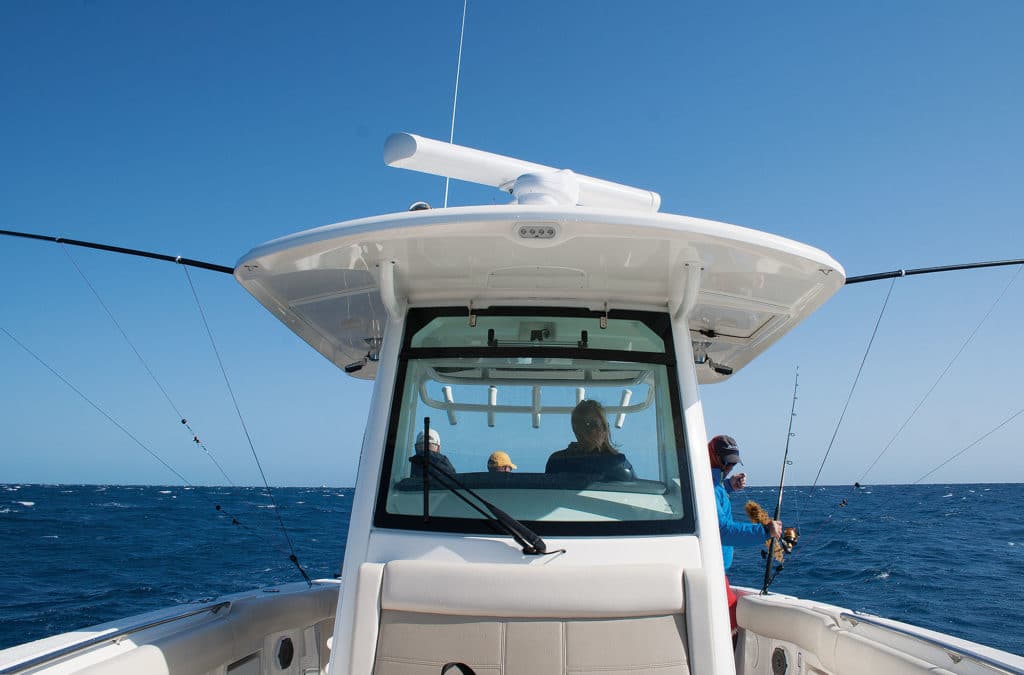
Net Results
Soon the ballyhoo schooled up, and with four deft tosses of the net, Jacobson plugged the standard 50-gallon covered transom livewell with baits. He could easily clear the transom and outboards while cast-netting astern thanks to gunwale tops that are free of snags and obstructions. To ramp up the bait capacity, order the livewell system that plumbs the 40-gallon compartment under the aft-facing bench.
As we made our way into the Gulf Stream, waves on our port beam built to five feet, but Rogers did not slow down. The boat continued to ride softly. The Lenco Auto-Glide dynamic trim-tab system kept the 330 on an even keel and at the perfect running angle. Compared to its predecessor, the new Outrage boasts a foot more length overall and a 16.6 percent increase in maximum horsepower rating.
I admire the way Whaler integrates the hardtop by recessing the stanchions within the console to save walkway space. The wraparound windshield extends to the underside of the hardtop to completely shield the helm, and a motorized vent atop the front panel cools the helm deck. Built-in steps on the hardtop stanchions and a hatch in the hardtop itself make it easy to go aloft should you add a tower to the 330. A pair of supportive helm seats feature flip-up bolsters to serve as leaning posts. For standing tall, a platform folds out from the seating pod to add 5½ inches of elevation. When seated, you can brace your feet on two tiers of angled footrests at the base of the console.
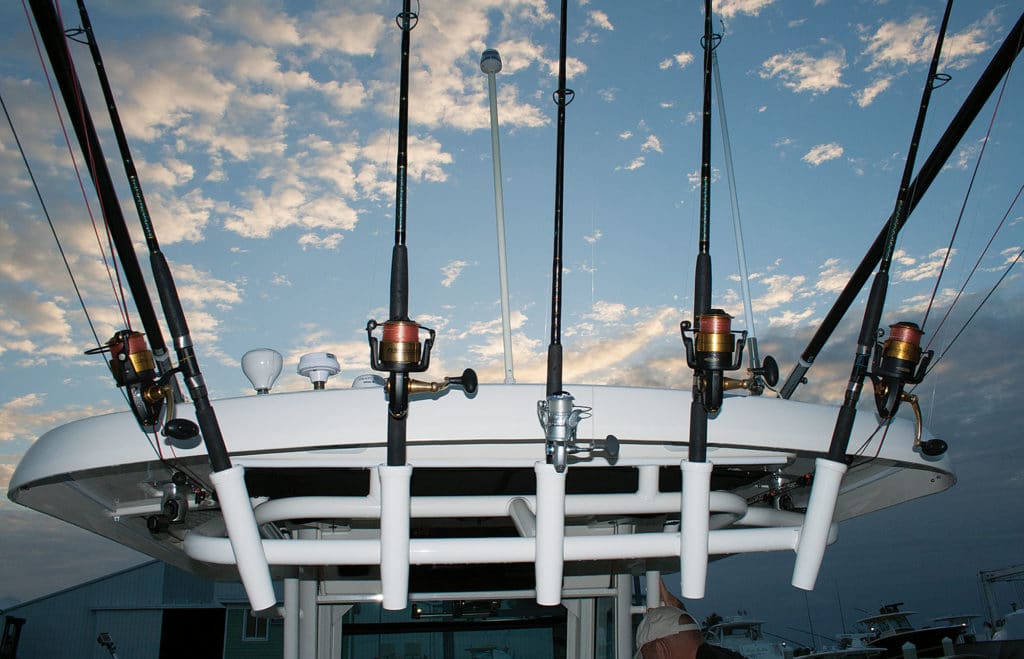
Lines In
Rogers employed the twin Raymarine gS165 multifunction displays (set in a black acrylic 44-inch-wide dash panel) to find the 120-foot mark near Carysfort Reef Light, where he brought the Verados to idle, or about 600 rpm.
The plan was to slow-troll the live ballyhoo for mahimahi and sailfish, so Jacobson deployed the Taco Marine 280 Grand Slam outriggers for two outside baits, then set out two inside baits on flat lines, with the rods placed in gunwale rod holders in each stern quarter. While trolling up-sea, Rogers placed both engines in gear; while down-sea, he kept only one engine in gear. In both cases, our speed over ground was around 2.5 mph.
The 330’s 10-foot-2-inch beam provided outstanding stability, even when turning in the wicked cross seas that day.
A school of mahi quickly crashed the baits, but none stuck, so we continued to troll. Davis relaxed in one of the optional jump seats that fold out from the gunwales aside the console, from which he could peer aft. Whaler calls these trolling seats, and indeed, they proved ideal for keeping an eye on the baits.
As we waited for another bite, I checked out the beefy inward-opening door on the port side of the aft cockpit, which eases boarding from floating docks. A stainless-steel quick-release boarding ladder (stowed in the head compartment) and swing-out grab handle let you use it as a dive door. In the starboard quarter, you’ll find a transom door that provides access to the aft swim platform, in case you need to step out and work a fish around the outboards.
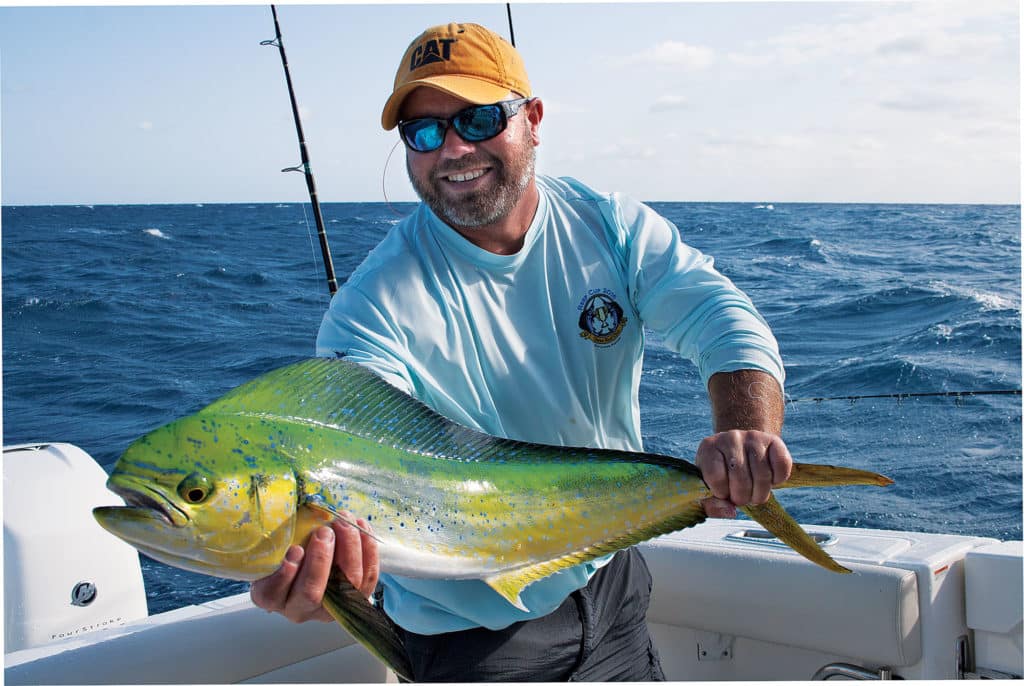
Hook Up
A snap of the port outrigger clip disrupted my inspection. A flash of gold flew airborne 75 feet astern, and I picked up the rod. As I played the frisky mahi, I appreciated the thickly padded coaming bolsters that encircle the deck. The 27-inch-high gunwales in the aft cockpit hit just above my knees, and the toe rail at deck level offered an extra measure of security.
The fish was soon boat-side, and Jacobson swung the mahi aboard. After a few pictures, we iced it in one of two 57-gallon insulated fish lockers that flank the aft deck.
About this time I was getting hungry, so I grabbed a sandwich and drink from the Isotherm fridge built into the seat console on the starboard side. This amenity proves convenient for keeping the crew nourished and hydrated, and it’s also great when entertaining. But my sandwich nearly went flying when Jacobson pointed out a sailfish attacking the bait on the starboard rigger. This time it was Lear’s turn. He gave the sail ample time to eat, feeding it line for 10 seconds, then flipped the bail closed and wound into the fish to set the circle hook. Two jumps into the fight, however, the sail came unbuttoned.
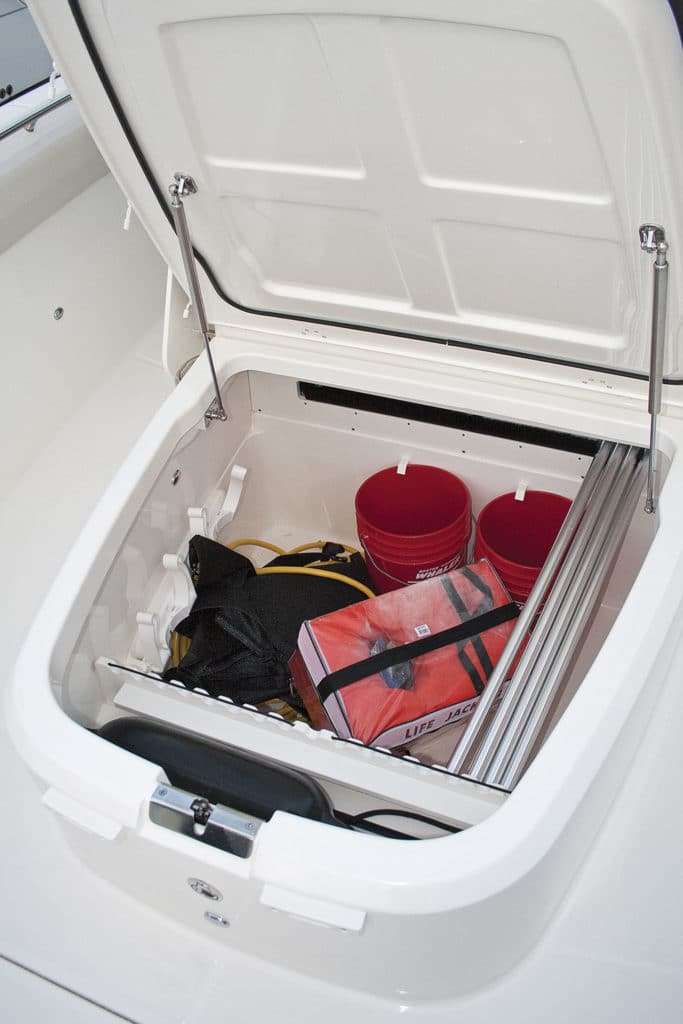
Performance Proof
It was fun while it lasted, but the time had come to head back and gather performance data in protected waters. First we had to drop off Jacobson at the marina to make an afternoon meeting. Despite the blustery conditions, docking the 330 Outrage in tight confines was easy thanks to the Mercury Joystick Outboard Piloting.
In testing, the twin 350 Verados propelled the 330 Outrage from zero to 30 mph in 11 seconds. The new Whaler achieved a top speed of 53.2 mph at 6,400 rpm, where the engines burned 60.3 gallons per hour for 0.88 mpg. Turning Mercury Enertia Eco 17-inch three-blade stainless-steel propellers, the Verados attained maximum efficiency at 4,000 rpm and 31.7 mph, where the fuel-burn rate was 21.3 gallons per hour for 1.49 mpg. That translates to more than 440 miles of cruising range based on the 300-gallon fuel capacity.
Ultimately, this boat offers a seaworthy, unsinkable platform to take offshore fishing with confidence or to entertain family and friends in comfort on days when catching is not a priority.
PERFORMANCE
POWER Twin Mercury 350 Verado outboards
LOAD 250 gal. fuel, four crew
TOP SPEED 53.2 mph @ 6,400 rpm
TIME TO 30 MPH 8.1 sec.
BEST MPG 1.49 @ 31.7 mph (4,000 rpm)
HULL
LOA 33 ft. 1 in.
BEAM 10 ft. 2 in.
DEADRISE 23 deg.
DRY WEIGHT Approx. 9,000 lb. (w/o engines)
DRAFT 22 in.
FUEL 300 gal.
MAX POWER 700 hp
MSRP $285,000 (base boat w/ twin Mercury 350 Verados)
Boston Whaler, Edgewater, Florida, 877-294-5645, bostonwhaler.com

